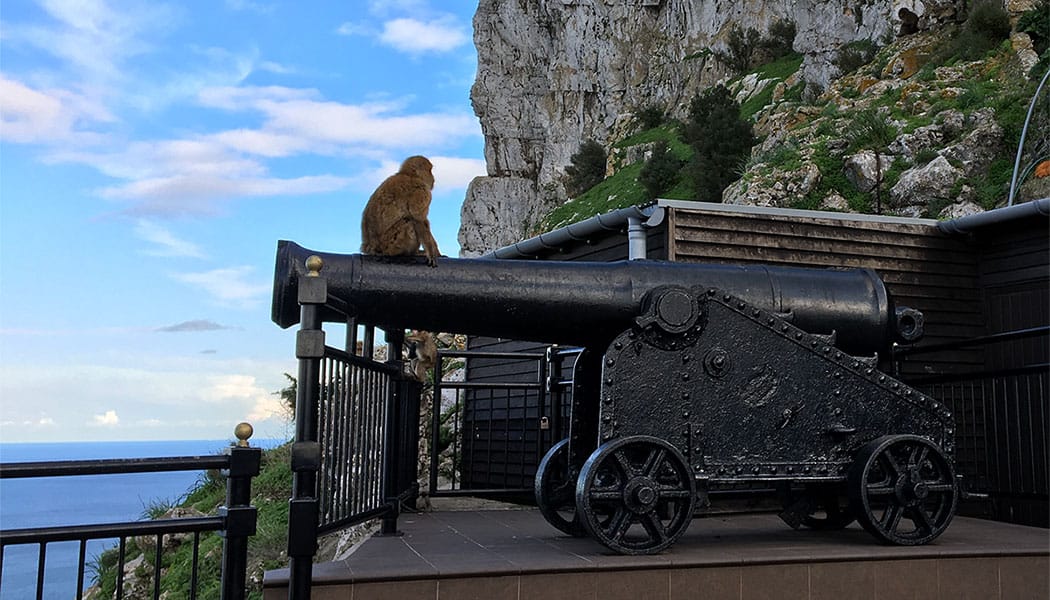
Although Gibraltar is small in a geographic sense – 2.6 square miles – there is no shortage of enjoyable tourist activities. Having only spent a few days in the British territory, I wasn’t able to see and do everything – but this guide will help you get started in planning your wheelchair accessible vacation.
Europa Point
The southernmost point of Gibraltar is known as Europa Point. Looking out across the Strait of Gibraltar, you may be able to see the coast of Morocco depending on the weather. While there isn’t much to do at the spot, it is a neat opportunity to view the continent of Africa while standing (or sitting) in Europe.
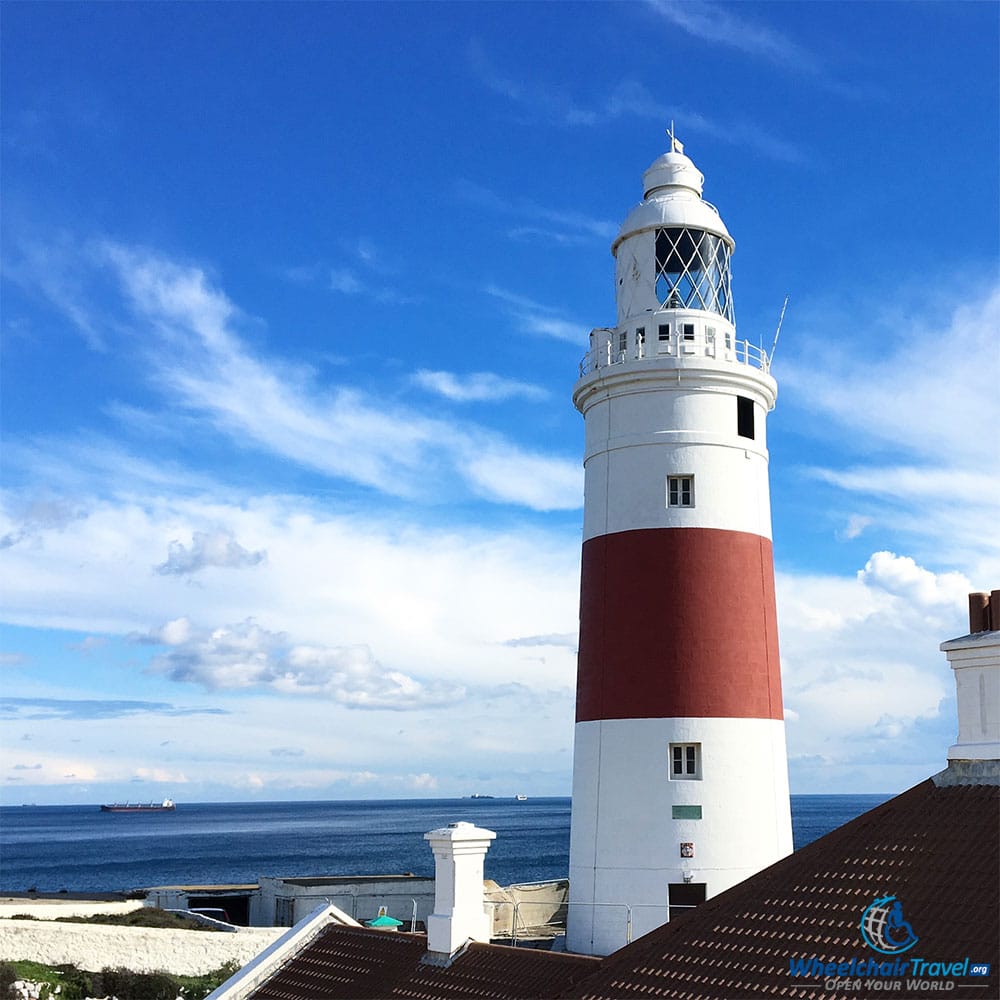
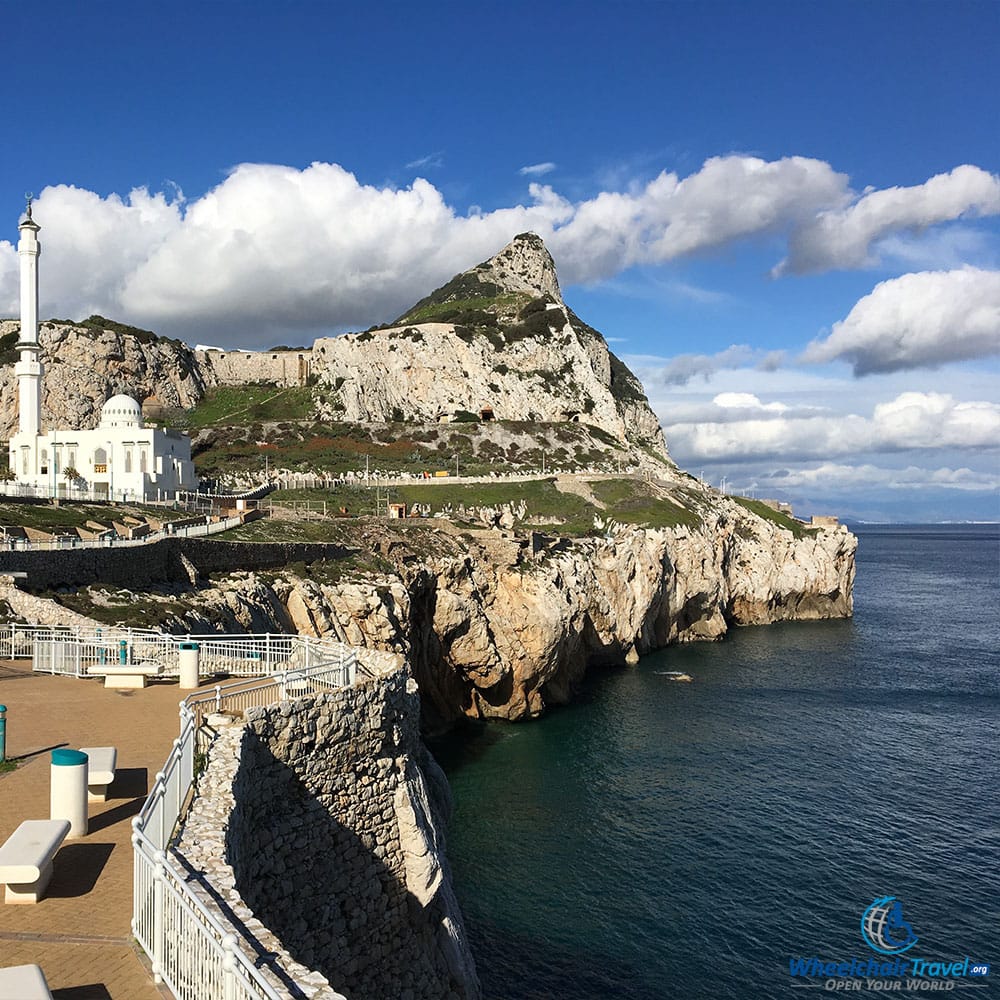
In addition to gazing towards Africa, you’ll have an excellent view of the rock in its entirety. The perspective, pictured above, is a bit different from what you’ll see from the city’s Old Town. An attractive lighthouse along the coastline also presents a fantastic picture-taking opportunity.
Europa Point is also home to the city’s Ibrahim-al-Ibrahim Mosque – a beautiful place of Islamic worship seen in the second photo above. For more information on the history of this mosque, click here. I have not been able to locate an official website.
The Rock of Gibraltar
No visit to Gibraltar is complete without a tour of the great Rock of Gibraltar. While its silhouette against the rising or setting sun is magnificent, there’s a great deal to see on the rock itself. I’ll discuss more of those below, but getting up there is a challenge you’ll need to address first.
Most tourists either scale the rock (via very steep streets and pathways), or take the cable car to the top. Sadly, neither of these options are accessible for a wheelchair user.
Another impediment is the fact that personal vehicles are generally not permitted atop the rock. Thankfully, there is an exception for persons with mobility impairments. Having seen the maneuvering required, I would strongly recommend that you hire a local driver/taxi to take you up – the roadways are narrow, steep, and vehicles are often inches from the cliffside.
The Gibraltar Taxi Association offers tours to the top of the rock and around to many of the city’s top sights. Prices are £90 for the first hour and £60 for each additional hour. A minimum booking of two hours is required. My tour lasted approximately four hours. You can read more about the taxi-assisted tour at www.gibtaxi.com. The accessible vehicles are different from those found in major cities around the world, so read my article on Wheelchair Taxis in Gibraltar for more information and photos of the accessible vehicles. Advance booking is required.
St. Michael’s Cave
The first stop you’ll typically make on the way up the rock is St. Michael’s Cave. After passing through a small gift shop built into the side of the rock, you’ll enter into the upper portion of a large ancient cave. The age of the limestone cave is a topic still under debate, but all agree that it was known to prehistoric humans. Art and drawings discovered on the cave’s interior walls date to 20,000 BC, but many believe the cave could be more than twice as old.
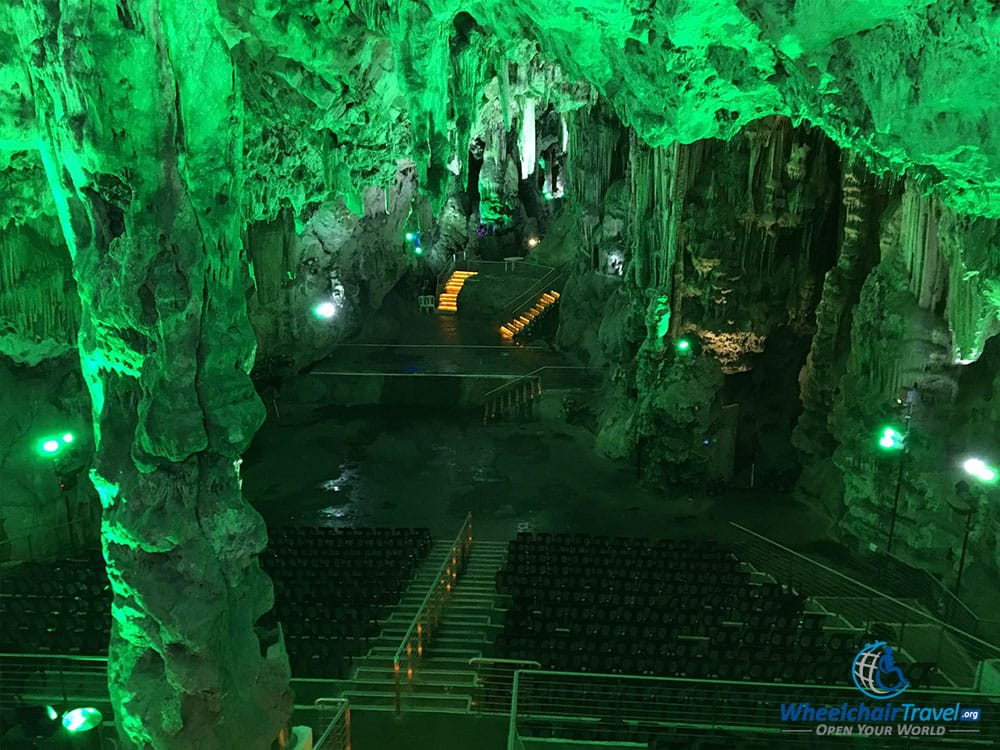
With stalagmites hanging from the rock ceiling above, you’ll be transfixed by the size of this natural creation. Since the 1960s, this centuries-old cave has been used as an auditorium – a venue for performances of all kinds, from music to ballet. Theater-style seating has been installed.
Sadly, the cave’s interior, which contains many levels and tunnels, is not accessible. A wheelchair lift does exist to take you to a level above the rear seating area of the auditorium, but you’ll need to navigate steps to move further. Should your trip coincide with a concert or performance there, you would be able to enjoy that – from the accessible space at the rear of the cave.
Is it worth a stop? For the wheelchair user, probably not. But, if you hire a taxi tour, you might as well take a peek inside. I spent no more than 5 minutes at St. Michael’s Cave, so you won’t need a lot of time – unless your physical ability allows you to venture further inside.
The Great Siege Tunnels
Like the rest of Europe, Gibraltar has experienced a long period of peace and general stability since the conclusion of the Second World War. Its history before that, however, particularly in the 17th, 18th and 19th centuries, was one of war and siege. The 14th or “Great Siege,” which lasted from 1779 to 1783, involved the French and Spanish coordinating an effort to expel the British from Gibraltar.
In 1782, work for a series of tunnels in the upper rock was commissioned. The purpose of the construction/excavation was to install cannons on the rock’s northern face. When the siege ended in February 1783, a tunnel with a length of nearly 400 feet had been created. Realizing the defensive advantage afforded by the tunnels and gun turrets, Gibraltarians continued this work after the siege – all the way through the end of World War II.
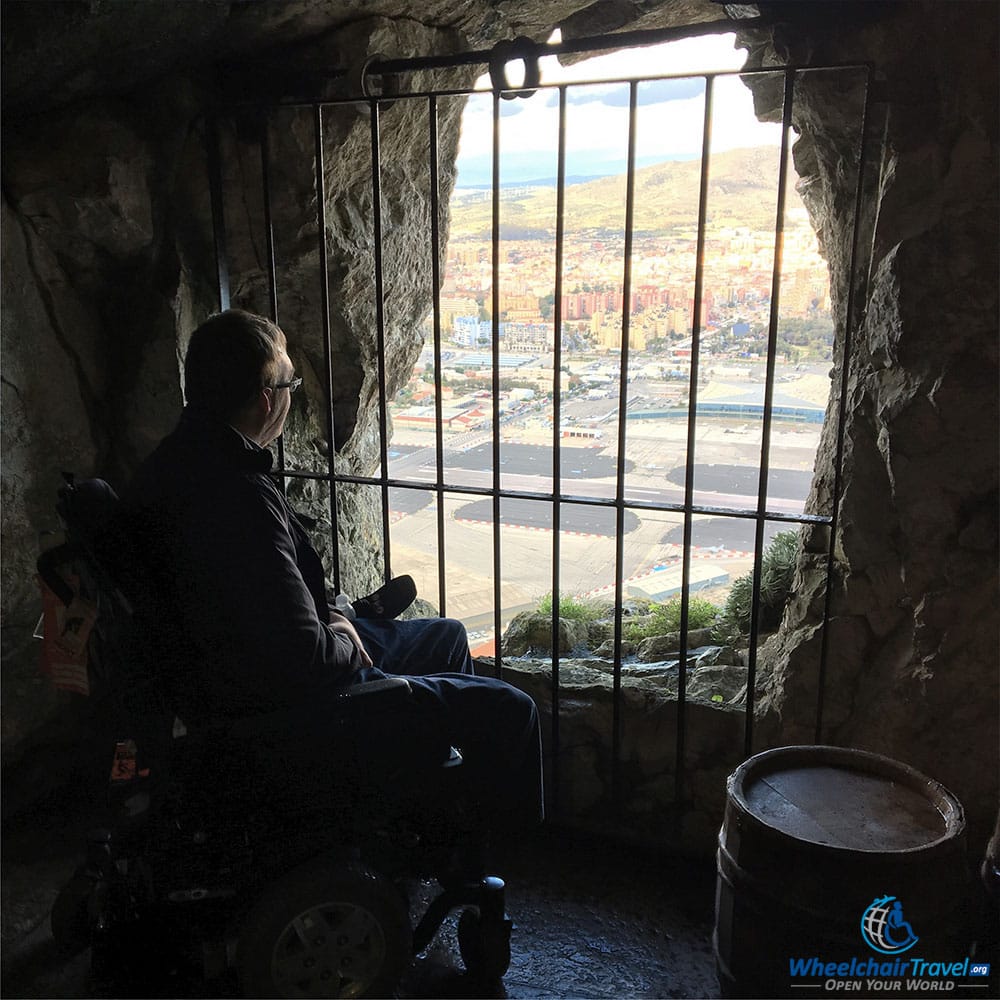
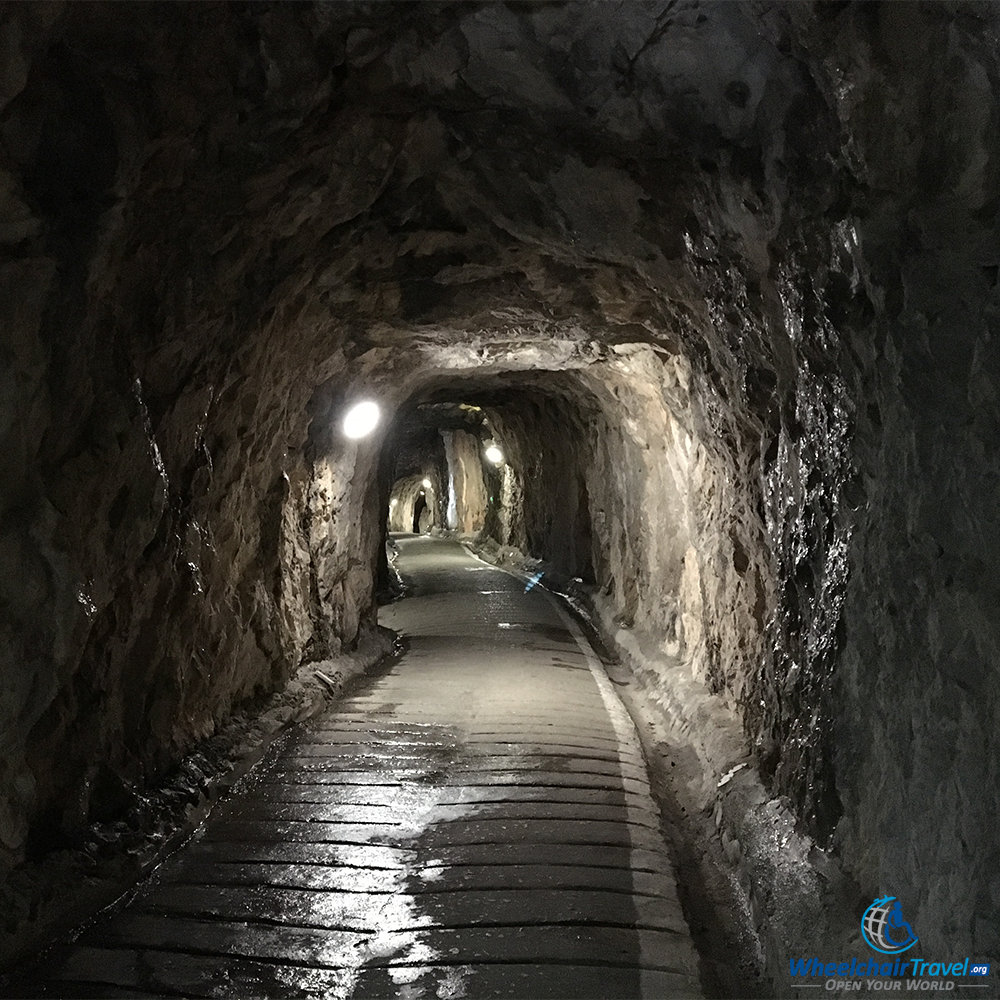
Today, more than 33 miles of tunnels exist inside the rock. While the vast majority is closed to the public, a portion including the original 370 feet, are open to the public.
The Great Siege Tunnels are wheelchair accessible. The first couple hundred meters are relatively flat, and offer access to information displays (describing the history of the tunnels), several cannons, and incredible views through the gun turrets. In the first photo above, you’ll see me looking out over the city and airport below from one of the former gun emplacements. On a clear day, the view is spectacular.
The second photo shows the paved pathway that leads through the tunnels. The deeper you go, the steeper the pathway gets. As you can see, the pathway is wide and in a good state of repair. My power wheelchair made it down into the tunnel and back without any issue. It was remarkable to see this incredible feat of excavation firsthand.
World War II Tunnels
In addition to the Great Siege Tunnels, a series of World War II tunnels – built lower into the rock – are also open to the public. This will be one of the last stops on a taxi tour of the Upper Rock.
Unfortunately, the World War II tunnels were closed on the day of my tour. My contact at the Gibraltar Tourism assures me that these are all wheelchair accessible. If you’ve had a chance to our them, please share your experience in the comments below. For more information on these wartime tunnels, see the article on the topic at www.visitgibraltar.gi.
Airplane Spotting (Activity)
To regular readers of this blog, it should be no secret that I am an aviation geek. I hate to admit it, but the primary reason I was interested in visiting Gibraltar was to engage in some airplane spotting.
What is particularly fascinating about this activity in Gibraltar is the fact that Runway 09/27 crosses an active vehicle roadway, Winston Churchill Avenue. As a result, the street must be closed – and vehicular traffic stopped – for every take-off and landing of an aircraft at Gibraltar International Airport. And yes, pedestrians (and wheelchair users) are allowed to cross the runway as well!

The average road closure lasts 10 minutes, and occurs multiple times throughout the day. The photograph above was taken right after I arrived at and left the airport – it shows pedestrians stopped at the runway crossing point, in preparation for an aircraft departure. You can check flight schedules on the airport’s website at www.gibraltarairport.gi.
Where can you take in the best views?
The Winston Churchill Avenue runway crossing is the closest spot, but it may not be the best. If you venture out to the marina, you’ll be able to roll out onto the docks – right at the far end of the runway, which extends into the water. If you time your tour of the Rock of Gibraltar correctly, you can take in the sight from above. My favorite view was from a platform just outside the Great Siege Tunnels:
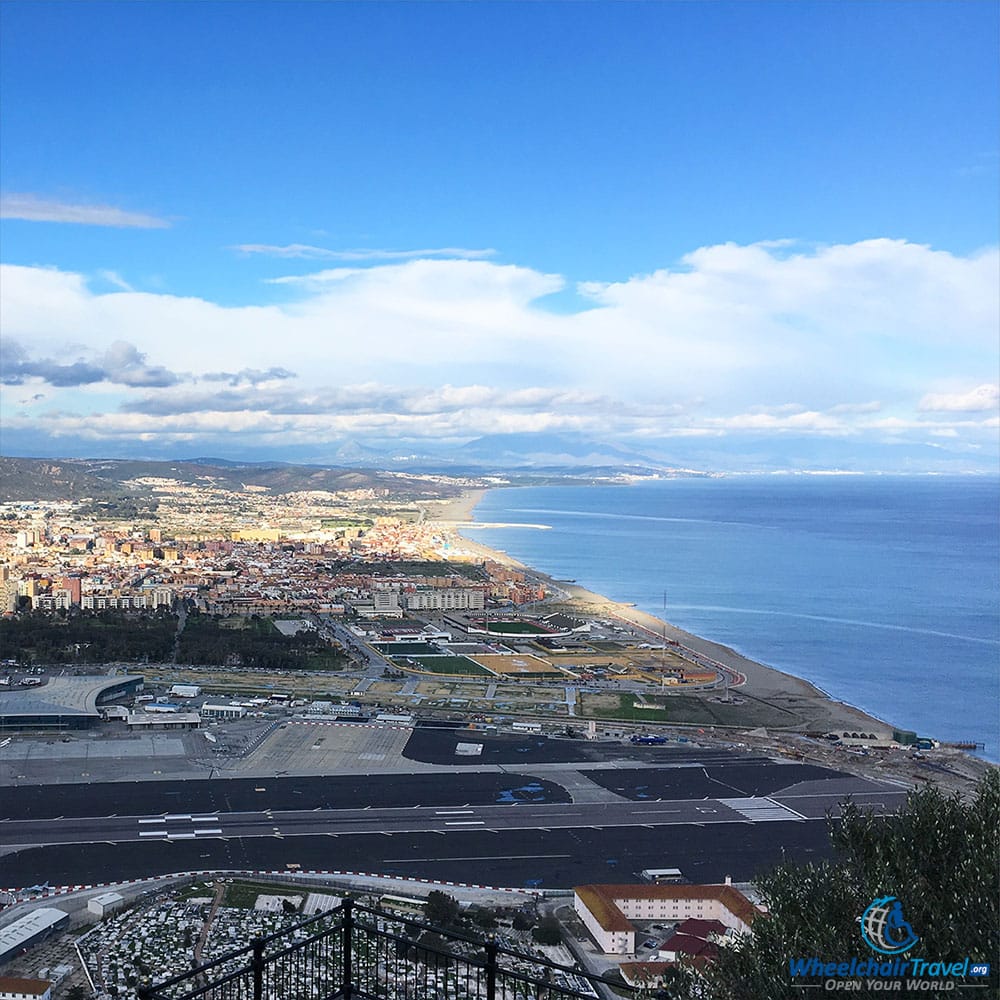
There is also a viewing deck in the secure area of the airport. Arrive early to watch your aircraft arrive on its inbound flight. If the weather is nice, aircraft typically arrive about one hour before their scheduled departure.
The largest airplane model currently used on scheduled passenger services is the Airbus A320-200, flown by both British Airways and Monarch Airlines. I watched several take-offs and landings from different vantage points, but focused my plane-spotting sessions on the arrival and departure of British Airways aircraft. They operate two flights per day in each direction, bound for London’s Gatwick Airport.
Trafalgar Cemetery
The Trafalgar Cemetery lies at the edge of Gibraltar’s Old Town, not far from The Rock Hotel. The first remains were buried in this cemetery in 1798, but the site is now named to commemorate the Battle of Trafalgar. The naval battle, an extension of the Napoleonic Wars, took place in October 1805. The British Navy, led by Admiral Lord Nelson, was outnumbered in ships, but defeated the Spanish and French combined fleet without a single hull loss.
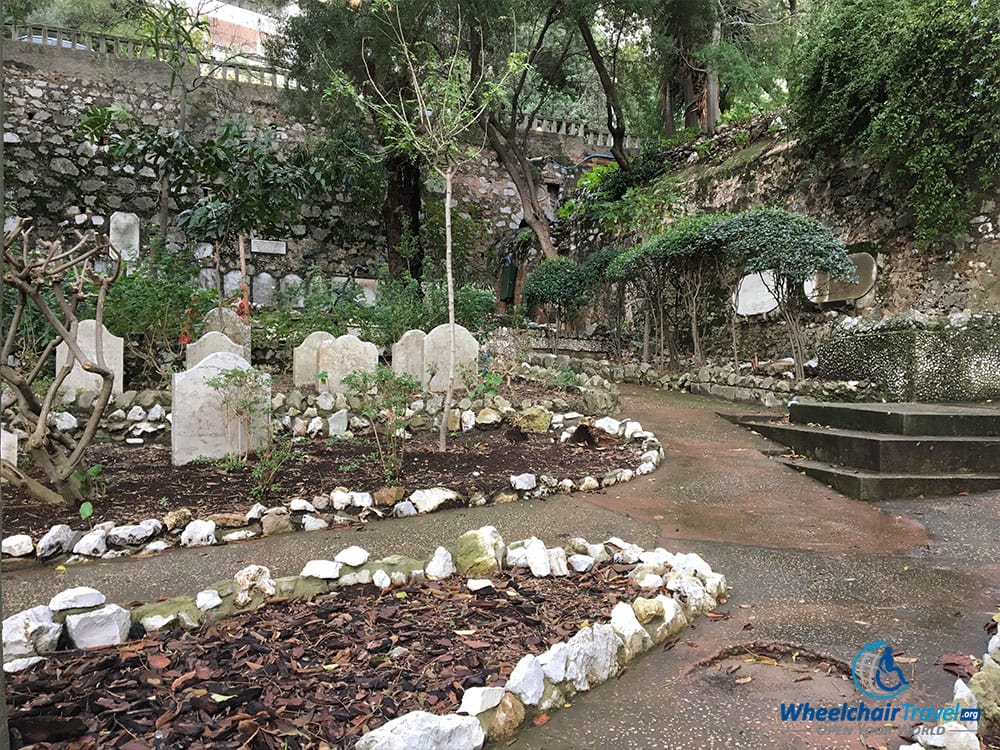
Admiral Lord Nelson was killed in the battle, making him one of Britain’s most storied war heroes. While most of the English dead were buried at sea or in London, two lieutenants who succumbed of wounds from the Battle of Trafalgar are buried here. The majority of the graves belong to Gibraltarians who lost their lives in the 1804 Yellow Fever epidemics. Still, this place is a testament to history, and has been preserved well.
Narrow pathways, paved with stone and cement, wind through the small cemetery, which takes up less than an acre of land. The pathways accommodated my power wheelchair with enough clearance, but I had to be conscious of each of my six wheels when maneuvering. The entrance from the street is a bit steep, so manual chair users may need assistance in safely rolling down (and back up). It was interesting to see the way the cemetery was placed up against the city’s defensive wall, but there are no historical giants buried there. The remains of Lord Nelson were sent back to London after the battle. Still, Trafalgar Cemetery is listed in the guidebooks, so you might as well spend a few minutes there – just to say you saw it!
Casemates’ Square
Grand Casemates Square is the city’s largest public square, located at the North terminus of Main Street. There are many bars and restaurants in this area. It is the center of downtown Gibraltar, and certainly an area you’ll end up visiting at least once.
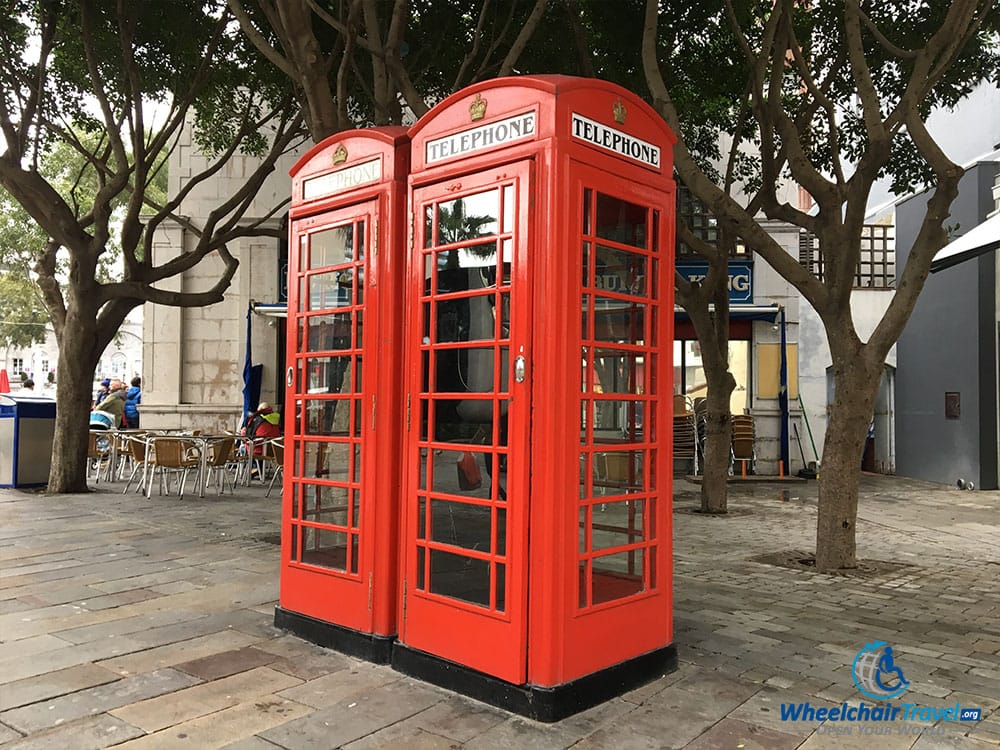
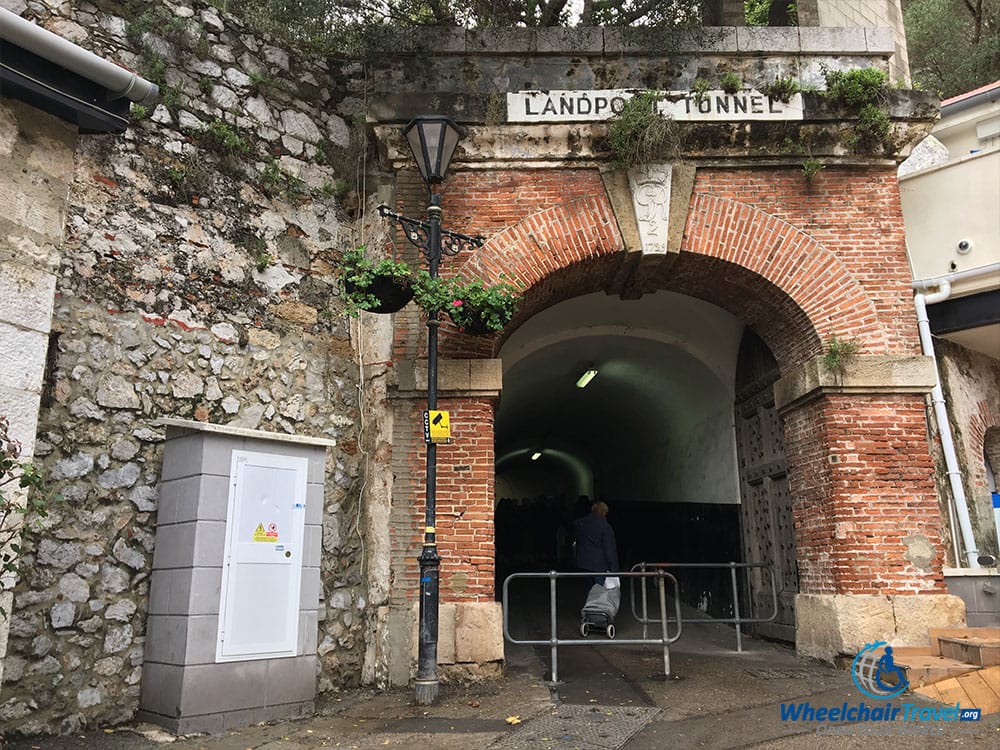
Of the restaurants and pubs on the square itself, I ate at only one – KFC. Sorry, but I’m not a food blogger. :p There were two things on the square that I would like to share, however. The first is a couple of red telephone booths, like those you would find in London. Very British, I’d say. Can you believe, I have never actually taken one of those classic photos WITH one of these? Perhaps it is because they are not wheelchair accessible. :p
The second photo is at the Northwest corner of the square. It depicts a tunnel through the city’s defensive wall. While there isn’t much to do at the end of this tunnel, you might take a few moments to pass through and inspect the wall more closely. You can also take a peek up the rock and see the Moorish Castle, which itself is sadly not accessible.
Main Street (Shopping & Dining)
Every city has a Main Street (right?), but Gibraltar’s is one you’ll remember forever. Set against the beautiful backdrop of the Rock of Gibraltar, you’ll find a picturesque avenue filled with shops, bars and restaurants. It’s a beautiful blend of British and Spanish culture – attracting a diverse group of people that is uniquely Gibraltarian.
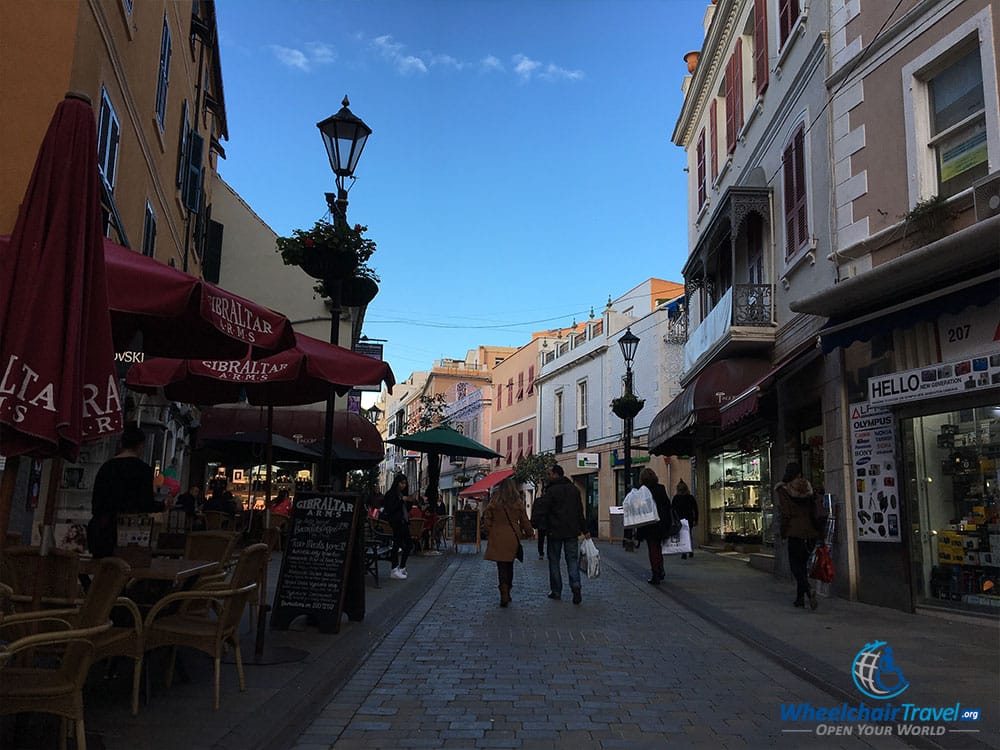
The picture above doesn’t do the sight justice. I took it after dining at the affordable Gibraltar Arms, where I had a pint and some pasta for less than 15 Pounds. Restaurants range from fast food to 5-star, and there is something for every taste. Similarly, the shops and stores vary – from souvenir shops directed at tourists to everyday and luxury clothing – boutiques and name brands.
My stroll on a December evening, with the temperature about 60°F (~15°C), was fantastic. You’ll enjoy shopping just as much as people-watching, and you’ll find that most businesses are accessible.
Cathedral of St. Mary the Crowned
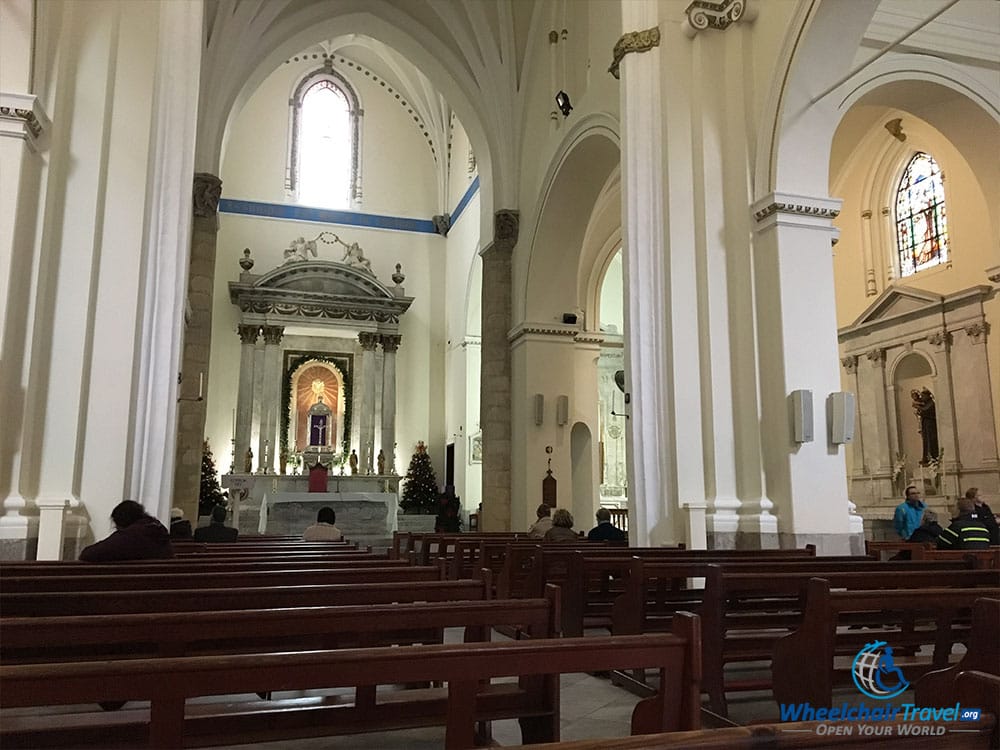
The Christian community at the now-Cathedral of St. Mary the Crowned, located on Main Street, was established in 1492 while Gibraltar was under Spanish rule. The site had previously contained an Islamic Mosque. Portions of the 15th-century church building still remain, but most of the present structure dates to the late-1700s.
Today, the cathedral church is home to a vibrant and multicultural community. It is the seat of the Bishop of the Roman Catholic Diocese of Gibraltar. The church’s main sanctuary and chapel are both wheelchair accessible, but the path between the two is not. Each has a separate accessible entrance – the main church from Main Street, and the chapel through a small courtyard (also on Main Street).
Gibraltar Marina
Marina Bay rests at the southern end of Gibraltar, extending out into the water alongside the airport’s runway. But the marina is not just a place to dock boats. The area contains a number of restaurants, a casino and the floating Sunborn Yacht Hotel.
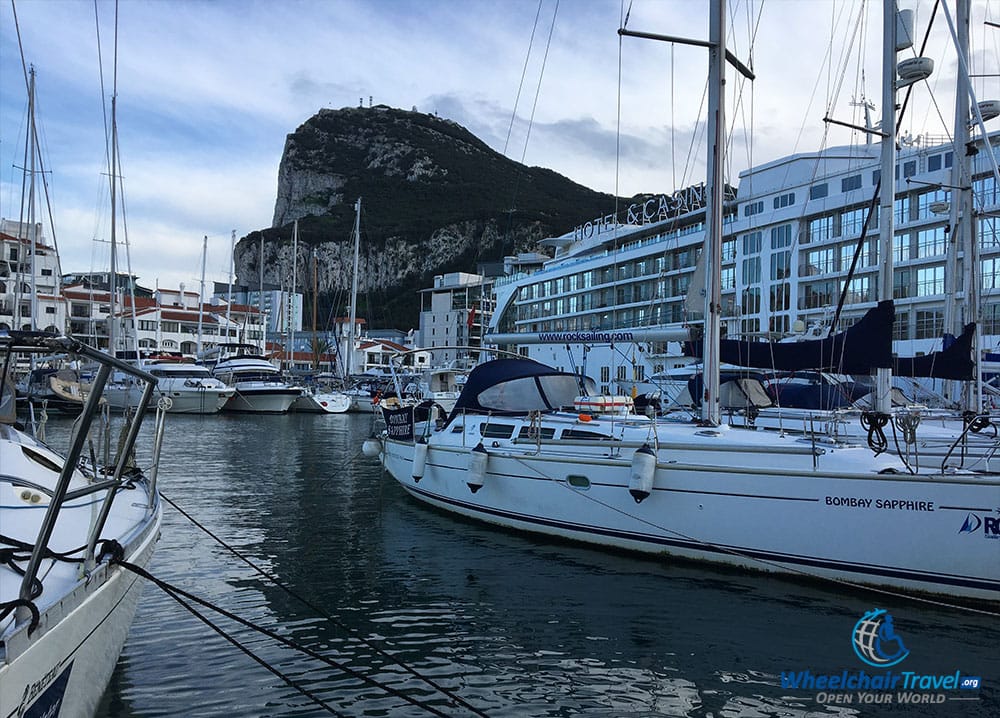
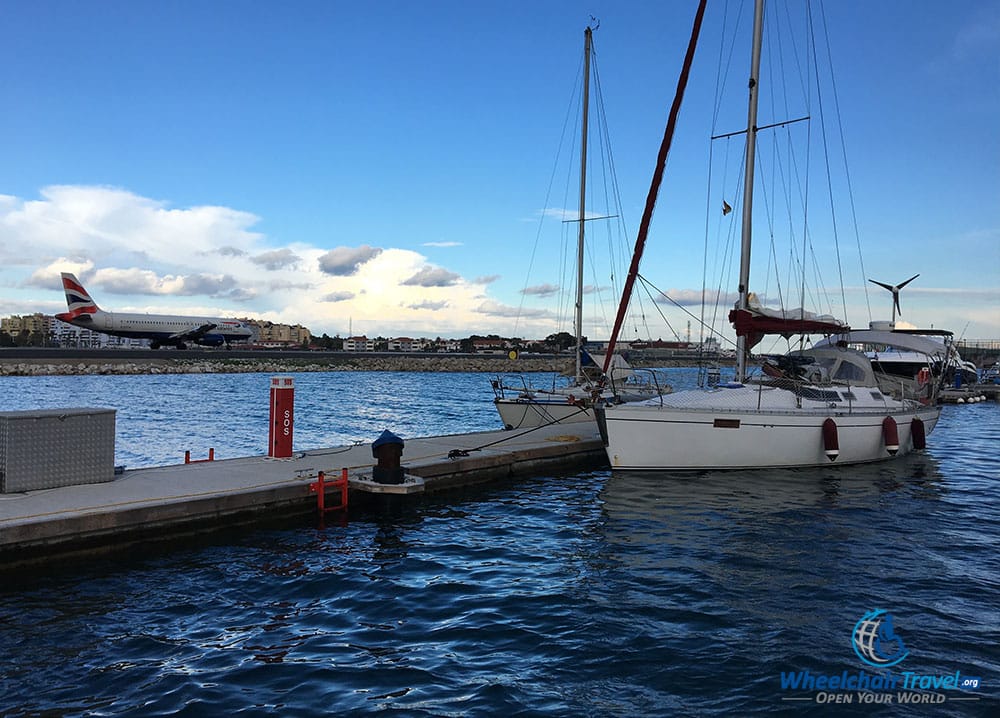
The marina also serves as a beautiful spot from which to take photographs. As mentioned earlier, the end of the marina’s docks is a fantastic place to observe take-offs and landings at Gibraltar International Airport. I had the fortune of seeing a British Airways A320 take-off from the marina.
Wheelchair users will find it easy to roll to the Marin from Main Street and Grand Casemates Square. Some of the pavements around the marina are made of cobblestone, but the docks themselves are constructed of wood.
Wheelchair Accessible Beaches
Although many coastal cities around the world lack accessibility at the beach, Gibraltar has invested in making beaches open to all. Adaptations include accessible parking spaces, ramps, mats placed over beach sand, free-to-use beach wheelchairs, hoyer lifts, and accessible bathroom/shower facilities.
Because I visited Gibraltar in December – outside of beach season – I was not able to test these facilities myself. I did ride by Eastern Beach, Catalan Bay and Camp Bay to verify that the ramps do exist. The Gibraltar Tourism Board, which oversees management of these accessible beach resources, also confirmed to me their commitment to upkeep. Staff at each beach provide assistance to wheelchair users and persons with disabilities seeking to use the accessible equipment.
The board has produced an accessibility guide (PDF) to the city’s beaches. This document provides all the information you need to take advantage of Gibraltar’s fabulous and picturesque beaches in an accessible manner.



